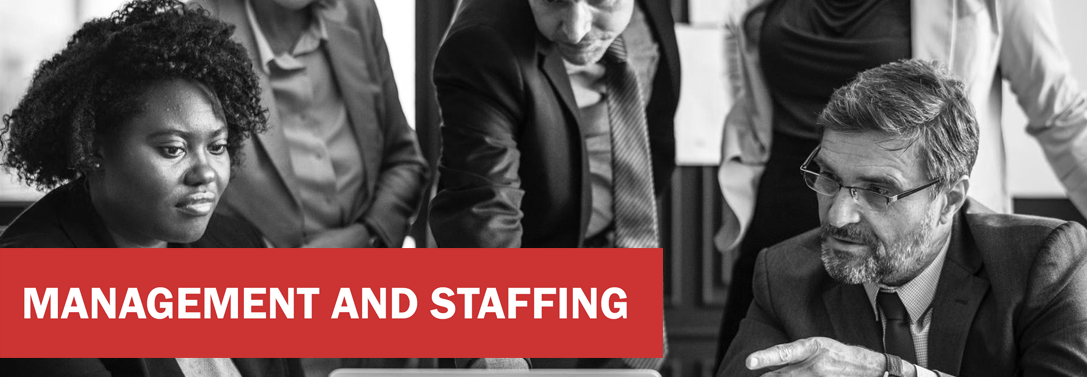
Nonprofit Management And Staffing
Build a high-performing organization with practical tools for leading people, managing performance, and shaping a culture where teams thrive.
This expert-led video collection brings real-world guidance on executive leadership, team structure, volunteer engagement, HR best practices, employee performance, and conflict management. Whether you’re hiring your first staff member or scaling a growing organization, these lessons help you align people with purpose and create workplaces rooted in mission, trust, and smart systems.
Learn how to assemble a mission-driven team, cultivate employee engagement and retention, and lead your people through change without burnout. Each episode offers actionable advice for navigating the organizational side of doing good—so your mission lasts and your people lead with confidence.

What happens when a kid who scribbles “play soccer at Ohio State” in kindergarten actually does it—and then decides his story shouldn’t be the exception? That question sits at the center of this episode with Channing Chasten, professional athlete and founder of The One Percent Kid Foundation.
From the start, Channing describes a childhood shaped by two steady forces: the soccer pitch and a mother who refused to let academics trail behind. Homework came first, the ball came second. Years later, that same mix of discipline and imagination is now driving a nonprofit built on three pillars: soccer, literacy, and mindset.
Channing explains why he believes in the power of tiny, consistent gains instead of giant leaps. As he puts it, “If you break it down into a small step, you realize starting is the easy part.” That simple idea—1% better every day—guides everything from his youth programs to his fundraising strategy.
We follow his journey through literacy camps where reading comes before drills, turning books into the ticket to soccer practice. He shares what he’s learning about plummeting reading scores, the heartbreaking link between third-grade literacy and incarceration, and why his team expanded from early grades to high schoolers who have already fallen behind.
The story widens as he walks through how he built a board full of nonprofit veterans and soccer leaders, deliberately choosing people who know both the sport and the sector. Their mentoring shapes his ambitions: building a national model starting in Arizona, creating mindset workshops in schools, and eventually launching a scholarship fund for under-resourced students who come through the program.
Along the way, we glimpse the grind behind the dream: chasing grants, securing a city award from Chandler, collecting impact data, filming quality videos so donors can actually see the work, and constantly revisiting big revenue targets in six- and twelve-month windows.
By the end, The One Percent Kid isn’t just a catchy name—it feels like an invitation to kids, donors, and communities to believe that small, steady progress can rewrite a life story.
#TheNonprofitShow #YouthSoccer #LiteracyMatters
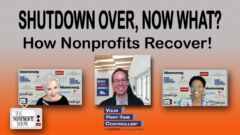
Federal shutdown over! Systems rebooting! Nonprofits on the clock! In this urgent episode, we bring back Derick Dreher, Department Leader, Government Funding at Your Part-Time Controller (YPTC)—just hours after the government reopens from the longest shutdown in U.S. history.
Derick starts with what happened in Washington: failed Senate votes, a last-minute continuing resolution, and a deal that funds government operations into January while restoring budgets for agencies like USDA and programs such as SNAP. But this is not just a civics lesson; it’s a compliance wake-up call for every nonprofit with federal awards.
Even though agencies were closed and portals were offline, he reminds viewers that obligations never went away. As Derick puts it, “It’s a challenge, but you still have to do it.” Reports due during the shutdown are still due. If a federal portal was off, organizations should have emailed, mailed certified copies, and documented every step. That paper trail may be the difference between a simple explanation and a “you’re in breach” notice now that systems are back up.
Derick explains that rules are shifting at the same time pressure is rising. An August executive order on federal grantmaking is reshaping Uniform Guidance and, in some cases, contradicting existing regulations. Nonprofits cannot simply move programs from October to November or rework budgets on their own. Any change—timelines, program design, vendors—requires permission.
The human side of this story is just as urgent. Federal employees returning from 43 days of furlough are staring at thousands of unread messages, while agencies are already dealing with staffing shortages. Automated payments and notices may resume quickly, but nuanced approvals, extensions, and clarifications will take time. That means nonprofits must expect delays while still operating at peak year-end demand and navigating food insecurity, SNAP disruption, and stretched donors.
Derick calls on leaders to treat this as a mini audit moment: review every award, update budgets and reports, clarify what did and didn’t happen during the shutdown, and then proactively request extensions and changes. “Federal awards are complicated beasts that have a lot of details and a lot of moving parts, and there’s no reason to be afraid of accepting them,” he says—if leaders build strong internal controls for timesheets, receipts, and documentation.
Above all, think of this as a reframe of the relationship with government funders: not as begging with an outstretched hand, but as a handshake partnership where authenticity, preparation, and transparency show you are leading with excellence. Get organized now, communicate wisely, and you can turn this chaotic shutdown into a proving ground for your nonprofit’s strength and mission focus.
#TheNonprofitShow #NonprofitFinance #GovernmentGrants
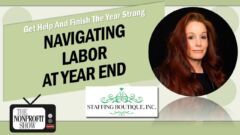
Nonprofits can absolutely finish the year strong—especially when they treat staffing as a strategic tool, not a scramble! In this energizing convo, Katie Warnock, founder and president of Staffing Boutique, maps out practical ways organizations can add capacity right when it matters most. Katie is plainspoken and solution-oriented: for major fundraising events, she recommends planning eight to nine months out and matching roles to real workload. “First of all, if you don’t have an events director, get one. If that’s not feasible, bring in a seasoned temp events director or an events manager to handle day-to-day logistics.” That approach keeps development leaders focused on relationships and revenue instead of table charts and coat checks!!
Katie outlines flexible staffing ramps—lighter hours early, surging near event day, then tight close-out to ensure donations, acknowledgments, and data entry are flawless. She is equally direct on year-end donor support: bring in skilled database professionals familiar with your CRM to process gifts fast and accurately. Volunteers are wonderful, but gift integrity demands pros.
Volunteer management gets a reality check. Holiday enthusiasm is great, but sustained help across the calendar—June, August, February—changes outcomes. Katie urges orgs to capture individual contacts from corporate volunteer days and cultivate them directly; today’s 22–32 year-olds become tomorrow’s major donors and often bring corporate dollars with them.
Looking beyond December 31, Katie champions prep projects that set teams up for a calm, effective new year: digitizing archives, standardizing folders and calendars, and documenting processes. She even shares a personal productivity win: embracing AI to tame an overloaded inbox. “Embrace AI… it’s here and it’s making so many things so much easier.” Finally, she models healthy team norms—blocks of focused work, breaks for movement and sunlight, and clarity on priorities—so coverage feels near 24/7 without burning people out.
Bottom line: think earlier, staff smarter, protect data, convert volunteers to champions, and set up systems now so January starts smooth. With the right mix of temps, consultants, and clear processes, your organization can thrive through year end and launch into the new year organized, energized, and ready to grow.

In this capstone to Nonprofit Power Week, Rita L. Soronen, President and CEO of the Dave Thomas Foundation for Adoption, looks forward—past the news cycle and into the work that will shape children, families, and the sector. In a calm, mentoring tone, Rita keeps leaders grounded in first principles: start with the child. As she puts it, “We’re not finding what child is best for a family, we’re finding what family is best for a child.” That mindset reframes recruitment, kinship care, and inclusion, and it calls leaders to stretch their own practices.
Rita shares how public attitudes toward foster care and adoption have matured, yet can backslide when sensational stories appear. Her counsel: hold firm to truth, trauma awareness, and mental health supports. She offers a practical compass for politicized climates: begin where everyone can agree. “Anyone here who’s ever been a child, please raise your hand… We have to bring it back to what’s best for children.” From there, leaders can convene consensus, reduce noise, and invite real collaboration across agencies, movements, and communities.
On funding and donor behavior, Rita maps the changing landscape—fewer donors, larger gifts, and strong interest in measurable impact and systemic change. The lesson for leaders is balance: keep legacy channels available while building digital fluency and fluency in donor-advised funds, non-cash assets, and planned giving. Pair that with scenario planning so your organization is resilient when markets, tax policy, or public health winds shift.
Rita’s advice on next-gen leadership is both warm and direct. Embrace impatience for progress, mentor toward mastery, and translate across generations. Model curiosity over eye-rolls; teach how boards govern, how budgets work, and how durable change is built—without dampening the urgency younger leaders bring.
Finally, Rita urges courage without fear. Hold your mission steady when funding anxieties rise. Convene unusual allies. Keep articulating the value of childhood, permanency, and family—then amplify shared ground loudly. Leaders who do this will guide teams and donors through uncertainty and keep children at the center, where they belong.
#TheNonprofitShow #Adoption #FosterCare
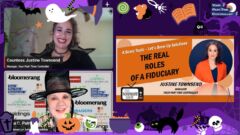
On this special Halloween edition of #TheNonprofitShow, Host Julia C. Patrick welcomes “Countess” Justine Townsend of Your Part-Time Controller (YPTC), to turn board governance fears into practical know-how. Capes, cobwebs, and clever metaphors aside, the lesson is real: fiduciary duties aren’t folklore; they’re law. As Justine explains, “you have a legal and ethical obligation to act on behalf of the organization with their best interest in heart.” Miss that, and the consequences can rattle a boardroom harder than a thunderclap.
First comes the duty of care. Think: show up, read the financials, ask questions, and make informed decisions. The monster here is the “ghost board member”—present in name only—who fails to notice a growing payroll tax balance. When the feds knock, there’s no hiding in the attic. Justine’s warning is blunt: “D&O insurance does not cover unpaid payroll taxes.” That’s a real-world jump scare.
Next is the duty of loyalty—less about blind allegiance and more about putting the organization’s interests ahead of your own. Enter the “vampire board member,” pushing a property sale that benefits them more than the nonprofit. The cure: annual conflict-of-interest disclosures, board recusals, and transparency. Bonus: checking the policy box (and posting it on your website) earns trust points with watchdogs like Candid.
Finally, the duty of obedience. No, not the toddler version. This means honoring laws, policies, donor restrictions, and—crucially—the mission. Beware the “zombie board member,” shambling after “money, money, money” while letting programs drift off-mission. That’s how donor restrictions get broken and how repayment claims can rise from the grave. File the Form 990 on time, disclose program changes, and keep mission, vision, and values stitched tightly together.
Throughout, Julia and Justine keep it witty and useful: schedule your COI renewals before year-end, disclose changes on the 990, and use fiscal sponsorship wisely during early program stages. The closing charm? A simple mnemonic: care (do the work), loyalty (put the org first), obedience (follow the rules). With that, your board won’t just survive spooky season—it’ll thrive all year.
#NonprofitFinance #BoardGovernance #TheNonprofitShow
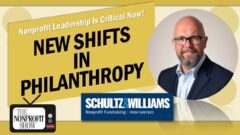
Craig Shelley, CEO of Schultz & Williams, joins Show host Julia Patrick, as they examine how philanthropy and nonprofit leadership are being reshaped under persistent uncertainty. Craig frames the moment succinctly: skepticism toward institutions is rising, which means nonprofits must state their values plainly and show exactly how funds power outcomes. The rubric he uses —“culture, brand, growth,” with culture first—becomes a practical lens leaders can apply immediately.
A central thread is fear—of economic signals, of language missteps, of technology’s speed. Craig notes that newer terms and jargon often widen the gap between sector insiders and the public. The remedy, he argues, is precision in communication and integrity in positioning. Julia observes a leadership pivot she’s hearing across the sector: “I’ve shifted my focus from task management to almost cheerleader,” which reframes modern leadership as energizing teams, not merely allocating tasks.
Remote work adds complexity: video meetings enable contact but thin relationships. Craig cautions that virtual convenience can erode the depth required for durable trust with colleagues and donors. He urges fundraisers—especially early-career professionals—to prioritize in-person relationship building. Otherwise, if their engagement stays purely digital, they compete directly with automated outreach. AI, in his telling, is already table stakes for efficiency—wealth screening, signal-based prospecting, and automated acknowledgments—but not a substitute for human rapport.
The conversation widens to concentric circles of stakeholders: start with staff, then the board, donors, and constituents. Invest in people first—reduce friction, understand motivations, build clarity. Curiosity is the catalyst. Craig’s own practice—asking about lives beyond job titles—models how depth is built. Julia adds a counterweight on “authentic leadership,” wryly noting that unfiltered authenticity can unsettle teams; leaders must project steadiness even while processing strain.
What emerges is a modern leadership compact: clarity about values, consistent communication, judicious use of technology, and intentional relationship work—especially in person. The sector’s generosity hasn’t waned; the environment around it has shifted. Navigating that shift means centering people and partnerships, then aligning tools to support, not replace, human connection.

Julia C. Patrick and Tony Beall get practical about recruiting fundraising talent when Q4 urgency is peaking. They open with empathy for development teams sprinting toward holiday giving, then move straight into the realities leaders must manage: retention, clarity, and smarter channels for sourcing candidates. Tony reminds us of the data behind turnover—average tenure around 19 months—and turns that into a charge for boards and executives to assess culture and expectations, not just replace people. “I’m an advocate of putting salary ranges in job postings,” he says, framing transparency as both respectful and time-saving for everyone.
The core lesson: start with a carefully crafted role. Compensation, deliverables, and core competencies belong upfront so you can source with precision. Julia pushes the conversation further: what if someone has been in the role for ten years? Tony offers a balanced lens—deep relationships can be a huge asset provided the organization’s future vision and the person’s strengths still connect.
From there, they map pathways to strong candidates: specialized job boards (AFP global and chapter sites, Chronicle of Philanthropy, local consulting firms’ boards), professional networks, and the university pipeline. Today’s philanthropic studies programs and micro-credentials (including LinkedIn Learning) expand opportunities for both organizations and professionals; mid-career learners with real-world experience can be exceptional hires. Julia points to the Lodestar Center at ASU as an example of a robust regional hub producing talent across ages and backgrounds.
They also cover the human side: discretion on LinkedIn (quietly indicating recruiter-friendly status), partnering with search firms, and managing communications in small communities where reputations travel fast. Tony’s encouragement is simple and memorable: “You have to be in it to win it.” That means showing up, telling trusted peers you’re exploring options, and being thoughtful about where and how you share.
The episode closes with practical optimism. Recruiting well isn’t about luck—it’s about clarity, channels, and consistent relationship-building. Name the role. State the range. Know the competencies. Post where fundraisers actually look. Tap universities and certificates. And keep your personal brand healthy—because your next opportunity often starts with the conversations you have today!
#TheNonprofitShow #FundraisersFriday #NonprofitCareers

ROI and culture rarely share the same sentence in nonprofit circles—yet that’s exactly the connection guest Carrie Wright (Wright Consulting) makes with co-hosts Wendy F. Adams and Julia C. Patrick. Carrie argues that retention, performance, and donor experience begin inside the walls: “You will never serve your clients beyond the level of which you serve one another.” If teams are burned out, poorly onboarded, or siloed, no amount of recruiting spend fixes the churn. As she puts it, leaders must “close the back door” with rigorous assessment, honest listening, and visible action.
Carrie’s playbook is practical. Start with anonymous pulse checks—quarterly if possible—to hear reality, not assumptions. Then act: cross-functional small groups, bridge-building across departments, and norms that reward collaboration instead of comparison. Culture work isn’t a memo; it’s a habit system. Think heat rising to a boil: one degree at a time until 212.
What about power dynamics? Carrie is clear that modeling starts at the top. Wall values must match hallway behavior. If leadership resists inside-out work but pushes customer-facing service, there’s a mismatch. That’s where courage comes in—for executives and for team members who “lead from where they sit.” Emerging leaders can shape tomorrow’s norms today through reverse mentoring, curiosity, and steady ownership.
Timelines matter. Culture change isn’t instant. Carrie has seen meaningful movement in six to nine months when leaders commit, communicate, and keep at it—while accepting pruning along the way. People will self-select out; that’s part of creating healthy soil. The gardener’s mindset applies: tend, water, weed, and measure growth.
Above all, the path forward is transparent: “Clarity is kindness.” Name the direction, keep conversations open, and invite people into the process—including the moments that are tough. Put culture on the same planning calendar as fundraising and events. If you’re asking donors to invest, demonstrate that you’re investing in your people with equal focus. The outcome? A mission that gains momentum because the team carrying it is strong, trusted, and aligned.
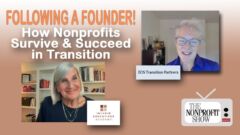
When a nonprofit founder steps away, the organization often faces one of the most emotional and uncertain chapters in its history. In this episode, Joan Brown, Chief Operating Officer at Interim Executives Academy, and Catherine Bradshaw, Senior Search Specialist at EOS Transition Partners, discuss the delicate art of following a founder and building stability during leadership succession.
Catherine begins, “When a founder leaves, the organization loses not only a leader but often its very identity. The board and staff must learn that the mission can thrive beyond the individual.” Her experience reveals that many boards have never navigated a leadership change — especially one that involves the founder who is the face of the organization.
Joan adds, “Interim leaders give organizations breathing space. When there’s no heir apparent, an interim provides structure, clarity, and a safe period to determine what the future needs to look like.” She reminds us that interim executives aren’t caretakers—they’re catalysts for readiness, shaping communication and confidence at every level of the organization.
Together, they address the emotional realities that come when a founder steps aside: staff anxiety, donor unease, and the founder’s own sense of identity loss. Catherine recommends coaching and structured off-boarding as essential supports: “Departing leaders need grace and guidance too. It’s about leaving the organization strong and knowing when to step fully away.”
Joan highlights the power of communication: “No one functions well with prolonged uncertainty. Clear communication with staff, donors, and community partners makes all the difference in a smooth transition.” Both guests advocate early succession planning and the importance of professional interim leadership to prevent crisis-driven change.
From retaining donor trust to defining new leadership roles, this sparkling conversation reveals why founder transitions, when managed thoughtfully, can be a time of renewal rather than instability. It’s a masterclass for nonprofit boards, executives, and founders who want to lead with foresight rather than fear.

Matt Glazer arrives with runner’s grit and a teacher’s patience, asking nonprofit leaders to reconsider what “success” really means when the pace gets punishing and the stakes feel permanent. Blue Sky Partners, he explains, is built on human-centered design—strategy that starts with people, not paperwork—because “things happen with people, not to them.” That simple reframing lands like fresh air in a room that’s been working on fumes.
Matt traces the practical path from North Star to next step. Vision and mission still matter; values still guide. But unless the destination is explicit, inertia becomes the manager. He’s seen organizations celebrate the wrong finish line—an amount raised rather than a result achieved—because the compass got swapped for a calculator. As he puts it plainly, too many teams make “the destination the money, not the mission,” and then feel failure in victory. His remedy: clarity that sequences choices—staffing, board composition, fundraising tactics—toward outcomes that last longer than a news cycle or a fiscal quarter.
The episode turns intimate as he describes leading through funding freezes and furloughs, where procurement bottlenecks stall workforce programs and rapid-rehousing efforts. Chaos, he says, is part of the system; the question is how leaders respond. That response writes the culture: junior staff learn what urgency means, what boundaries are allowed, and whether development is an investment or an afterthought.
Matt’s answer is rhythm. He prefers “work-life rhythm” to balance, because real life surges and ebbs. Micro-rituals—a brain break after deep work, a morning run, hand-ground coffee, ten minutes of reading—become the scaffolding of steadiness. Leaders who model the pause (even leaving early after a 3 a.m. crisis) give permission for healthier habits and better listening. From there, skills compound: interns become staffers, staffers rise to managers, managers to directors, directors to chiefs.
He doesn’t preach from a distance. Matt shares his own burnout and mental-health journey, the season when achievement eclipsed wellbeing. That candor reframes self-care as operational sense, not personal luxury. The nonprofit sector is vast—and fragile—precisely because it relies on people whose calling meets constraints. Protect the people, he argues, and you protect the mission.
This episode is an invitation to re-set: name the North Star, measure what matters, and let rhythm replace adrenaline. Strategy becomes humane. Operations become sustainable. And the work—housed within leaders who can breathe—can keep going for a long time.
#TheNonprofitShow #NonprofitLeadership #HumanCenteredDesign
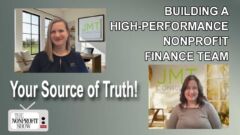
Nonprofits talk about programs, fundraising, and boards—but rarely about how to build and lead a modern finance team. JMT Consulting’s Taylor Bost and Samantha Tiso deliver a clear, practical playbook for turning finance from a back-office function into a strategic engine.
Samantha reframes the relationship right out of the gate: “We view the finance department as the customer support for the rest of the company.” That posture—service, responsiveness, and clarity—reduces fear, boosts collaboration, and speeds decisions. It also demands better systems. As she puts it, “With the right system… that is possible if you have it structured the right way.” Translation: good data in, fast insight out.
Taylor widens the lens to organization-wide alignment. Finance is not just P and L. It is grants, restrictions, repeat donor behavior, and cost to raise a dollar—metrics that reshape priorities across teams. That is why she pushes for a single ‘source of truth’ and warns against siloed tools: when data is scattered, people end up re-keying information and fixing errors. Her reminder lands: “Every time a human’s touching something… you’re opening yourself up to room for error.”
Measurement matters too—of the finance team itself. Taylor offers practical KPIs any CEO or board can use: monthly close time, volume of audit adjustments, and adoption of automation. If close cycles are drifting from 5–7 business days to 15–20, there is friction you can remove with better workflow, integrations, and roles.
Governance shows up repeatedly. Samantha adds: “The C-suite needs to be looking at it. The board needs to be looking at it.” Confidence in numbers is confidence in the organization. And with grantmakers demanding more frequent and better-substantiated reports, integrated systems are no longer optional—they are essential.
The quick-paced convo also tackles outsourced and remote finance. Success hinges on clear ownership of recurring tasks, documented deadlines, and transparent communication channels. Taylor’s advice: break the monthly engine into parts—reconciliations, payment application, approvals—so nothing stalls.
The icing on the cake? We get a preview of Innovate 2026 conference and JMT’s three-decade journey—from early outsourced accounting to full-stack finance technology and process advisory. Samantha shares how Innovate blends training with thought leadership on grants, banking, interest rates, and board communication, ensuring every role—from CFO to controller to ops—walks away with practical upgrades.
Big takeaway: modern nonprofit finance is a service mindset plus integrated tech plus shared accountability. Or in Taylor’s words, “CFOs step a little bit more into the tech strategy role.” When finance leads with service and systems, everyone rows in the same direction—and mission moves faster.

Financial leadership is more than numbers—it’s the heartbeat of nonprofit sustainability. In this Nonprofit Power Week finale of The Nonprofit Show, Regional Director Ellie Hume of Your Part-Time Controller (YPTC) brings clarity and candor to some of the most frequently asked financial questions. With an “Ask and Answer” format, the conversation covers everything from roles and responsibilities in financial leadership to the evolving landscape of fractional CFOs.
Ellie sets the stage by redefining how we see finance in nonprofits: “Finance is literally the thread that draws every piece of the organization together because without it, nothing works.” She dismantles silos by urging finance professionals to engage deeply with program, marketing, and development teams to ensure that data isn’t just accurate but also meaningful for decision-making.
The discussion takes a practical turn as Ellie differentiates between controllers, comptrollers, and CFOs. She outlines the transactional oversight of controllers, the governmental nuance of comptrollers, and the strategic future-focus of CFOs. She also digs into the importance of internal controls, noting their role in fraud prevention and audit readiness.
The lively session shifts into the governance space. How often should boards review and sign Conflict of Interest (COI) policies? Ellie’s answer is clear: annually at minimum, but immediately when new conflicts arise. She gives a relatable example: a contractor-board member bidding on a capital campaign project must disclose and recuse themselves. Transparency, she argues, isn’t optional—it’s fiduciary duty.
Ellie also challenges assumptions about credentials. Do finance directors need to be CPAs? Her answer: “You truly just need great accounting skills and a strategic mindset to help the organization use financial information to make good business decisions.” Certifications like CPA or CMA add credibility but don’t replace experience or practical skill.
The conversation also explores the rise of fractional leadership. Ellie frames fractional CFOs as an efficient way to access high-level talent at a fraction of the time or cost, particularly useful during transitions or to prepare for a new hire. Fractional arrangements, she explains, can be both short-term bridges and long-term partnerships.
The conversation wraps with a powerful reminder for board members: ask tough financial questions. Are resources aligned with mission? What risks are we facing? Do internal controls hold up? And crucially—what training do board members need to responsibly interpret financial statements?
#TheNonprofitShow #NonprofitFinance #FractionalCFO
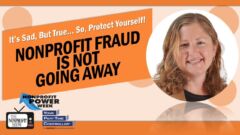
In this Nonprofit Power Week conversation, we sit down with Jen Blasy, Manager at Your Part-Time Controller, to confront a topic many organizations would rather avoid: fraud in the nonprofit sector. Jen is unequivocal about the stakes: “Fraud has been a constant. It may look different, but it’s still happening.” She explains why the sector’s empathy, trust, and lean staffing models can unintentionally create exposure—especially in a remote and hybrid world where e-mail, text, and chat now mediate so many approvals and financial transactions.
Jen moves past labels to show how fraud actually occurs. She refreshes the classic “triangle” of pressure, rationalization, and opportunity by adding capability and personal ethics, then wraps it all in culture. Tone at the top matters, she notes, because expectations, zero tolerance, and open conversation are often the only real deterrents. “We need to normalize the discussion of it so that it becomes more normal to talk about,” Jen adds, urging leaders to speak plainly with staff, boards, auditors, and yes—donors—about risks and responsibilities.
Concrete scenarios make the message land. From stolen cards being “tested” on donation pages to refund requests designed to route money out through alternate channels, Jen shows how seemingly donor-friendly instincts can be weaponized. She pushes organizations to map their most common money-in and money-out pathways, document updated controls that fit remote workflows, and rehearse a response plan before a crisis. Who do you call first? Legal counsel, your insurer, your auditor, a board champion? Decide now, not mid-incident.
The throughline is sector solidarity. Because incidents are underreported and under-prosecuted, offenders can quietly move from one organization to another. Jen challenges leaders to think beyond their own walls and treat transparency as community protection. Make fraud risk a standing board agenda item, ensure auditors’ annual fraud conversations are substantive, and appoint an internal champion to coordinate policies, training, and continuous improvement.
Fraud will not be eliminated, but its impact can be contained by stronger culture, modernized controls, and candid conversation. This episode equips executives, finance teams, and fundraisers alike to recognize where they’re vulnerable and to act. As Jen frames it, progress starts when we stop whispering about fraud and start planning together.
#TheNonprofitShow #NonprofitFinance #FraudPrevention

Nonprofits want the speed of automation and the promise of AI—but Alicia Eastvold, Department Leader for Client Technology Solutions at Your Part-Time Controller (YPTC), explains why many orgs stall at the starting line: messy, bloated, and fragmented data. Her central thesis is simple and powerful: “We can’t speed things up if it’s not organized, and we can’t write simple rules around it for where it belongs.” From the first minute, Alicia reframes “data hygiene” away from fear and toward usefulness—think Marie Kondo for systems: keep what serves the mission, archive the rest, and label everything so your “smart assistant” can actually find the hammer.
Alicia maps two common failure modes: too much information (endless, unreadable reports) and poor structure (the same concept scattered across donor CRM, accounting, and spreadsheets). Both grind automation to a halt and produce costly mistakes in grant allocations, budgets, and forecasts. Her practical fix: decide what you need going forward, set a cutoff, inactivate legacy categories, and build simple, durable rules that can run 1,000 times. As she puts it, “Think big about what would happen if I had to do this thing a thousand times and plan your process that way.”
A standout story: a client wanted a complex custom payroll allocation tool. After examining their cluttered chart and inconsistent rules, the team cleaned the system, documented clear rules, and discovered an off-the-shelf cost allocation tool that did the job at a fraction of the price. Takeaway: better structure often beats bespoke code.
The stakes are real. Misallocations can snowball into seven-figure problems, finger-pointing between development and finance, and restricted funds that can’t be used where they’re most needed. Clean, rule-based data unlocks credible budgeting, forecasting, and the ability to ask funders for the right dollars—including flexible, unrestricted support. It also fuels data storytelling that boosts trust and investment: when leaders visualize program costs, funding gaps, and outcomes with clarity, credibility skyrockets.
Bottom line: start today. Choose what matters for the next 12–24 months, archive the past, enforce naming and categorization rules, and think like an enterprise—no matter your size. Clean data returns time to your people, turns AI from buzz to utility, and powers decisions that move the mission!

Scenario planning often sounds like a board retreat buzzword, but in this Nonprofit Power Week episode it becomes a practical playbook with receipts. Director Tesa Piccioni of Your Part-Time Controller (YPTC) reframes uncertainty as a routine operating condition, not a meteor strike. Her thesis is disarmingly simple: “Let’s take the un out of uncertainty and accept that certain things are going to happen. Let’s prepare.” Preparation, she argues, isn’t about predicting every storm—it’s about building a habit of visibility and fast pivots.
We start with the kitchen-table finance questions: What do you have? What do you owe? What’s promised in and promised out? From there, the “boring” stuff—clean records, timely allocations, grant restrictions, and a rolling forecast—becomes the organization’s superpower. As Tesa puts it, “If you have good information in, you get good information out—and that lets you act, not just react.” She expands the aperture beyond budgets: think balance sheet integrity, a just-in-case line of credit, and board fluency in financials so decisions don’t stall during turbulence.
The clever twist: scenarios aren’t just bad-news drills. Tesa insists on planning for lucky breaks too—unexpected windfalls, mergers, or a connector board member who opens doors. That $1.5M surprise check? Without a plan, it’s chaos with confetti. With a plan, it’s momentum.
Her practical framework pairs SWOT with three starter lenses: revenue up, revenue down, and environmental change. Master those, and you’re not memorizing scripts; you’re training reflexes. Equally important, it’s not a finance-only sport. Program leads, executives, and boards need shared situational awareness so services continue even if the lights don’t.
Tesa links this directly to strategy: strategic planning sets the destination; scenario planning keeps the route open when reality tosses detours. Review cadence? Not annually—responsively. The moment regulations shift, funds lag, or opportunities appear, open the playbook and adjust. That rhythm replaces anxiety with calm, which is precisely what constituents deserve.
The payoff is cultural: organizations stop operating in crisis posture and start operating with poise. Think FEMA’s checklists, but for food banks, youth programs, and arts orgs—quiet competence that protects the mission on ordinary Tuesdays and extraordinary Thursdays alike.
#TheNonprofitShow #ScenarioPlanning #NonprofitFinance
